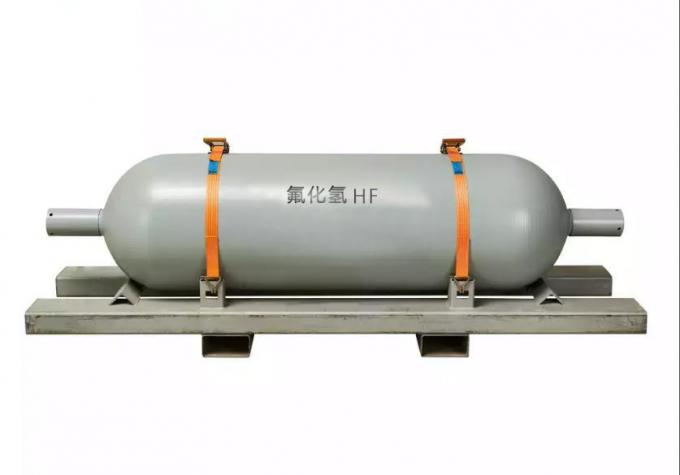


| MOQ: | 1kg |
| Price: | US $2/kg |
| Standard Packaging: | Cylinder/Tank |
| Delivery Period: | 15 days |
| Payment Method: | L/C, T/T |
| Supply Capacity: | 50000kg/month |
Hydrogen fluoride (HF) gas is a colorless, highly corrosive, and toxic gas. It is composed of one hydrogen atom bonded to one fluorine atom. HF is a compound of fluorine, which is the most electronegative element, making HF highly reactive and capable of dissolving many materials, including glass.
Here are some key points about hydrogen fluoride gas:
Properties: Hydrogen fluoride is a gas at standard temperature and pressure. It has a pungent odor and can be detected even at low concentrations. HF is highly soluble in water, and when dissolved, it forms hydrofluoric acid (HF(aq)), which is equally corrosive and poses similar health risks.
Industrial Applications: Hydrogen fluoride is used in various industrial processes. It is commonly employed in the production of fluorocarbons, which are used as refrigerants, propellants, and as raw materials in the manufacturing of plastics and polymers. HF is also used as a catalyst and in the production of aluminum, uranium, and other metals.
Health Hazards: Hydrogen fluoride is extremely corrosive and toxic. It can cause severe burns on contact with the skin and eyes. Inhalation of HF gas or its vapors can lead to respiratory distress, lung damage, and potentially fatal systemic effects. Chronic exposure to low levels of HF can result in long-term health complications.
Safety Precautions: Handling hydrogen fluoride requires strict safety measures. Personal protective equipment, such as chemical-resistant gloves, goggles, and respiratory protection, should be worn when working with HF. Adequate ventilation and engineering controls, such as fume hoods and exhaust systems, are necessary to minimize exposure.
Emergency Response: In the event of an HF exposure, immediate medical attention is crucial. Affected individuals should be moved to fresh air, and contaminated clothing should be removed. Contact with HF should be rinsed with copious amounts of water, and medical professionals should be informed of the exposure for appropriate treatment.
Due to the severe health hazards associated with hydrogen fluoride gas, its handling, storage, and use should strictly adhere to safety guidelines and regulations. Proper training, risk assessments, and emergency response procedures are essential when working with HF.
| Model No: | HF | Purity | 99.95%% |
| Transport Package | ISO Tank/Cylinder | Specification | ISO Tank/Cylinder |
| Appearance | CMC | Origin | Suzhou,China |
| HS Code | 2812190091 | Production Capacity | 30000 Metric Ton Per Year |
Specification:







| MOQ: | 1kg |
| Price: | US $2/kg |
| Standard Packaging: | Cylinder/Tank |
| Delivery Period: | 15 days |
| Payment Method: | L/C, T/T |
| Supply Capacity: | 50000kg/month |
Hydrogen fluoride (HF) gas is a colorless, highly corrosive, and toxic gas. It is composed of one hydrogen atom bonded to one fluorine atom. HF is a compound of fluorine, which is the most electronegative element, making HF highly reactive and capable of dissolving many materials, including glass.
Here are some key points about hydrogen fluoride gas:
Properties: Hydrogen fluoride is a gas at standard temperature and pressure. It has a pungent odor and can be detected even at low concentrations. HF is highly soluble in water, and when dissolved, it forms hydrofluoric acid (HF(aq)), which is equally corrosive and poses similar health risks.
Industrial Applications: Hydrogen fluoride is used in various industrial processes. It is commonly employed in the production of fluorocarbons, which are used as refrigerants, propellants, and as raw materials in the manufacturing of plastics and polymers. HF is also used as a catalyst and in the production of aluminum, uranium, and other metals.
Health Hazards: Hydrogen fluoride is extremely corrosive and toxic. It can cause severe burns on contact with the skin and eyes. Inhalation of HF gas or its vapors can lead to respiratory distress, lung damage, and potentially fatal systemic effects. Chronic exposure to low levels of HF can result in long-term health complications.
Safety Precautions: Handling hydrogen fluoride requires strict safety measures. Personal protective equipment, such as chemical-resistant gloves, goggles, and respiratory protection, should be worn when working with HF. Adequate ventilation and engineering controls, such as fume hoods and exhaust systems, are necessary to minimize exposure.
Emergency Response: In the event of an HF exposure, immediate medical attention is crucial. Affected individuals should be moved to fresh air, and contaminated clothing should be removed. Contact with HF should be rinsed with copious amounts of water, and medical professionals should be informed of the exposure for appropriate treatment.
Due to the severe health hazards associated with hydrogen fluoride gas, its handling, storage, and use should strictly adhere to safety guidelines and regulations. Proper training, risk assessments, and emergency response procedures are essential when working with HF.
| Model No: | HF | Purity | 99.95%% |
| Transport Package | ISO Tank/Cylinder | Specification | ISO Tank/Cylinder |
| Appearance | CMC | Origin | Suzhou,China |
| HS Code | 2812190091 | Production Capacity | 30000 Metric Ton Per Year |
Specification:





